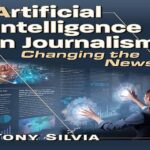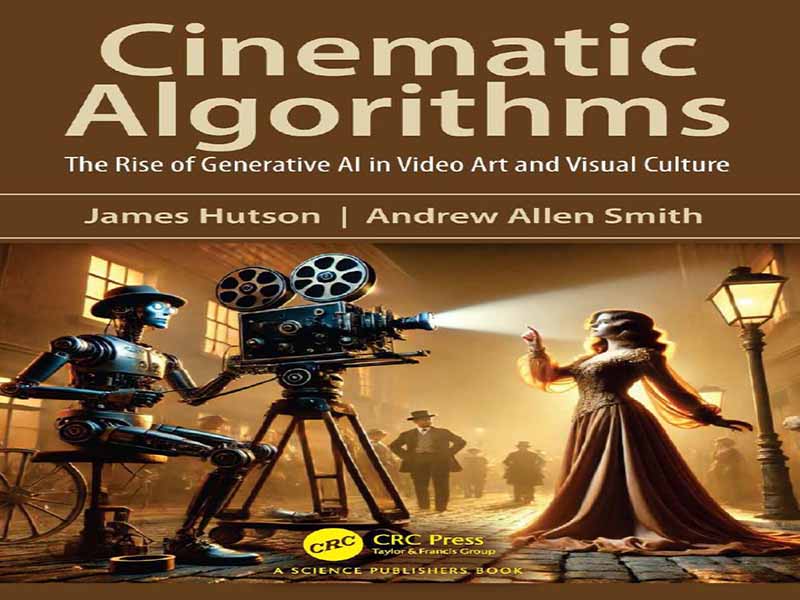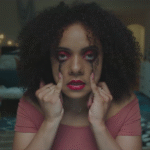- عنوان کتاب: Cinematic Algorithms -The Rise of Generative AI in Video Art and Visual Culture
- نویسنده: James Hutson
- حوزه: سینما
- سال انتشار: 2025
- تعداد صفحه: 226
- زبان اصلی: انگلیسی
- نوع فایل: pdf
- حجم فایل: 6.69 مگابایت
از اولین روزهای سینما، پتانسیل فناوری برای متحول کردن داستانسرایی، نیروی محرکهای برای نوآوری بوده است. وقتی ژرژ ملییس در سال ۱۹۰۲ از فیلم «سفری به ماه» (Le Voyage dans la Lune) رونمایی کرد، مخاطبان از جلوههای ویژه پیشگامانه او شگفتزده شدند. این فیلم کوتاه، با سفر خیالیاش به ماه، جلوههای بصری را به عرصه آورد و نشان داد که چگونه صحنهها و تصاویر تخیلی میتوانند از طریق قدرت رسانه نوظهور سینما، مخاطبان را مجذوب خود کنند. با بلوغ صنعت سینما، تکنیکهایی مانند استاپ موشن و مت پینتینگ به کارگردانان اجازه داد تا دنیاهای جدیدی مانند میمون غولپیکر در کینگ کونگ (۱۹۳۳) یا مناظر خارقالعاده در جادوگر شهر اُز (۱۹۳۹) خلق کنند. این روشها انقلابی بودند و به قصهگوها ابزارهایی برای تجسم داستانهایی میدادند که قبلاً فقط در تخیلاتشان وجود داشتند. دههها بعد، ظهور تصاویر تولید شده توسط کامپیوتر (CGI) دوران جدیدی را به ارمغان آورد. پارک ژوراسیک در سال ۱۹۹۳ با دایناسورهای واقعگرایانهاش مخاطبان را شگفتزده کرد و استاندارد بالایی برای جلوههای ویژه تعیین کرد که میتوانست به اندازه خود روایت الهامبخش باشد. پس از آن، پیشرفتهایی در ضبط حرکت رخ داد که به طور مشهور در فیلمهایی مانند آواتار (۲۰۰۹) و ارباب حلقهها (۲۰۰۱-۲۰۰۳) مورد استفاده قرار گرفت، جایی که شخصیت گالوم استاندارد جدیدی را برای واقعگرایی CGI تعیین کرد. نوآوریهای تکنولوژیکی هر دوره، فیلمسازان را قادر ساخت تا داستانهایی را روایت کنند که انتقال آنها به روش دیگری غیرممکن بود و بدین ترتیب مرزهای خلاقیت سینمایی را جابجا کردند. جدیدترین نسل ابزارها، که توسط هوش مصنوعی مولد (GAI) پشتیبانی میشوند، تغییری را ایجاد کردهاند که فراتر از صرفاً افزایش جلوههای بصری است: این فناوری خود رسانه را دموکراتیک میکند. کارهایی که زمانی به تیمهای بزرگی از متخصصان نیاز داشتند، اکنون میتوانند توسط یک خالق واحد با دسترسی به پلتفرمهای مبتنی بر هوش مصنوعی انجام شوند. یک فیلمساز انفرادی میتواند با این ابزارها، نقشهای کارگردان، فیلمبردار، تدوینگر و هنرمند جلوههای بصری را، همه از طریق یک رایانه شخصی، انجام دهد. این تغییر در فناوری نه تنها دسترسی به تولیدات با کیفیت بالا را گسترش داده، بلکه پیشینه فیلمسازان را نیز متنوع کرده است. در حالی که مراکز تولید سنتی مانند لسآنجلس، بمبئی، پکن و سئول مدتهاست که بر این صنعت تسلط دارند، نسل جدید خلاقان هوش مصنوعی در سراسر جهان، از مناطق روستایی جنوب هند گرفته تا حومه فرانسه، پراکنده شدهاند. همانطور که در این کتاب بررسی خواهد شد، این فیلمسازان GAI را نه صرفاً به عنوان یک ابزار، بلکه به عنوان یک نیروی توانمندساز و محبوب برای داستانسرایی میبینند. این فناوری به آنها اجازه میدهد تا از ساختارهای سنتی دروازهبانی در صنعت عبور کنند. بدون نیاز به تجهیزات گرانقیمت، تأیید استودیو یا بودجههای کلان، اکنون طیف وسیعتری از صداها راه خود را به این رسانه پیدا میکنند. این تغییر به این معنی است که فیلمهایی میتوانند ظهور کنند که منعکسکننده طیف متنوعتری از دیدگاهها، داستانها و تجربیات فرهنگی نسبت به گذشته باشند. بسیاری از فیلمسازانی که در این کتاب به آنها پرداخته شده است، از پیشینههای غیرسنتی، از بازاریابی و برنامهریزی گرفته تا هنرهای زیبا و عکاسی، میآیند. با وجود ریشههای متنوعشان، آنها با درک عمیقی از روایت و تمایل به گسترش مرزهای داستانسرایی بصری متحد هستند. فرآیندهای خلاقانه این فیلمسازان بسیار متفاوت است. برخی با ابزارهای تصویرسازی مولد، مانند Midjourney، شروع به تولید مفاهیم اولیه یا استوریبورد میکنند که سپس به سکانسهای ویدیویی کامل تبدیل میشوند. برخی دیگر با عکاسی یا آثار هنری خود شروع میکنند و این تصاویر را به مولدهای ویدیوی هوش مصنوعی مانند Pika یا Runway میدهند تا کلیپهای کوتاه تولید کنند. برخی از تکنیکهای تبدیل ویدیو به ویدیو استفاده میکنند و فیلمهای خود را به آثار کاملاً جدید تبدیل میکنند. پس از تولید، این کلیپها اغلب در نرمافزارهای ویرایش مانند Adobe Premiere Pro تحت اصلاحات بیشتری قرار میگیرند و پیشرفتهای بیشتری در نرمافزارهای جلوههای بصری مانند Cinema 4D به آنها اضافه میشود. تطبیقپذیری این گردشهای کاری، انعطافپذیریای را نشان میدهد که ابزارهای جدید GAI به فیلمسازی میآورند – به سازندگان اجازه میدهد تا به روشهای منحصر به فرد و بسیار شخصیسازی شدهای که به بهترین وجه با دیدگاه آنها مطابقت دارد، کار کنند. با این حال، مانند هر تغییر بزرگی در صنعت، ظهور فیلمسازی مبتنی بر هوش مصنوعی، عدم قطعیت را برای استودیوهای تثبیتشده به همراه دارد. در حالی که برخی، مانند Lionsgate، در حال حاضر در حال آزمایش هوش مصنوعی برای پیشتجسم هستند، برخی دیگر محتاطتر هستند. رهبران صنعت، از جمله کارگردانانی مانند جیمز کامرون، به هیئت مدیره شرکتهای هوش مصنوعی پیوستهاند و اظهار میکنند که ادغام این فناوری در فرآیند فیلمسازی صرفاً حدس و گمان نیست، بلکه اجتنابناپذیر است. از نظر تاریخی، هر جهش تکنولوژیکی – از CGI گرفته تا تدوین دیجیتال – چشمانداز را تغییر داده و نقشهای جدیدی ایجاد کرده و در عین حال نقشهای دیگری را منسوخ کرده است. تکامل سریع هوش مصنوعی نیز آماده است تا تغییرات مشابهی را ایجاد کند، اما با سرعتی بیسابقه. فیلمسازی با هوش مصنوعی، اگرچه ریشه در یک سلسله طولانی از نوآوریهای سینمایی دارد، اما در دورانی از تغییرات سریعتر و مخربتر در حال ظهور است. در گذشته، با رواج بیشتر CGI، هنرمندان استاپ موشن و نقاشان مات شاهد کاهش نقشهای خود و جایگزینی آنها با موقعیتهای جدید در جلوههای بصری بودند. اکنون، سرعت پیشرفت به این معنی است که
From the earliest days of film, the potential of technology to transform storytelling has been a driving force behind innovation. When Georges Méliès unveiled Le Voyage dans la Lune (A Trip to the Moon) in 1902, audiences marveled at his groundbreaking special effects. This short film, with its fantastical journey to the moon, brought visual effects to the forefront, showcasing how imaginative scenes and visuals could captivate audiences through the power of the emerging medium of cinema. As the film industry matured, techniques like stop motion and matte paintings allowed directors to create new worlds, such as the giant ape in King Kong (1933) or the fantastical landscapes in The Wizard of Oz (1939). These methods were revolutionary, giving storytellers tools to visualize stories that previously lived only in their imaginations. Decades later, the advent of computer-generated imagery (CGI) brought about a new era. Jurassic Park astonished audiences in 1993 with its realistic dinosaurs, setting a high bar for special effects that could be as awe-inspiring as the narrative itself. This was followed by advancements in motion capture, famously utilized in films like Avatar (2009) and The Lord of the Rings (2001–2003), where the character Gollum set a new standard for CGI realism. The technological innovations of each era enabled filmmakers to tell stories that would have been impossible to convey otherwise, thus pushing the boundaries of cinematic creativity. The latest generation of tools, powered by generative artificial intelligence (GAI), has introduced a shift that goes beyond merely enhancing visual effects: it democratizes the medium itself. Tasks that once required large teams of specialists can now be accomplished by a single creator with access to AI-powered platforms. A solitary filmmaker can, with these tools, fulfill the roles of director, cinematographer, editor, and visual effects artist, all from a personal computer. This shift in technology has not only widened access to high-quality production but has also diversified the backgrounds of those creating films. While traditional production centers like Los Angeles, Mumbai, Beijing, and Seoul have long dominated the industry, the new generation of AI creatives is dispersed across the globe, from rural Southern India to the French countryside. As this book will explore, these filmmakers see the GAI not merely as a tool but as an empowering, popularizing force for storytelling. The technology allows them to bypass traditional gatekeeping structures within the industry. Without the necessity of expensive equipment, studio approval, or large budgets, a wider range of voices are now finding their way into the medium. This shift means that films can emerge that reflect a more diverse array of perspectives, stories, and cultural experiences than ever before. Many of the filmmakers featured in this book come from non-traditional backgrounds, ranging from marketing and programming to fine arts and photography. Despite their varied origins, they are united by a deep understanding of narrative and a desire to push the boundaries of visual storytelling. The creative processes of these filmmakers vary greatly. Some start with generative image tools, like Midjourney, to produce initial concepts or storyboards, which then evolve into full video sequences. Others begin with their own photography or artwork, feeding these images into AI video generators like Pika or Runway to produce short clips. Some employ video-to-video techniques, transforming their own footage into entirely new creations. Once generated, these clips often undergo further refinement in editing software such as Adobe Premiere Pro, with additional enhancements added in visual effects software like Cinema 4D. The versatility of these workflows illustrates the flexibility that new GAI tools bring to filmmaking— allowing creators to work in unique and highly personalized ways that best suit their vision. Yet, as with every major shift in the industry, the rise of AI-driven filmmaking brings uncertainty for established studios. While some, like Lionsgate, are already experimenting with AI for pre-visualization, others are more cautious. Industry leaders, including directors like James Cameron, have joined AI company boards, suggesting that the integration of the technology into the filmmaking process is not merely speculative but inevitable. Historically, every technological leap—from CGI to digital editing—has reshaped the landscape, creating new roles while rendering others obsolete. The rapid evolution of AI stands poised to effect similar changes but at an unprecedented pace. AI filmmaking, while rooted in a long lineage of cinematic innovation, is unfolding in an era of faster and more disruptive change. In the past, as CGI became more prevalent, stop-motion artists and matte painters saw their roles diminish, replaced by new positions in visual effects. Now, the pace of advancement means that filmmakers and industry professionals have less time to adapt to the new tools and the possibilities they present. While the technology reshapes the film industry, Hollywood has garnered significant media attention—especially highlighted during events like the well-publicized 2023 Writers Guild of America (WGA) Strike. The labor protest underscored a variety of concerns about how AI is poised to transform creative industries, from scriptwriting to pre-visualization, and hinted at deeper implications for creative authorship and intellectual property within mainstream filmmaking.
این کتاب را میتوانید از لینک زیر بصورت رایگان دانلود کنید:
Download: Cinematic Algorithms



































نظرات کاربران